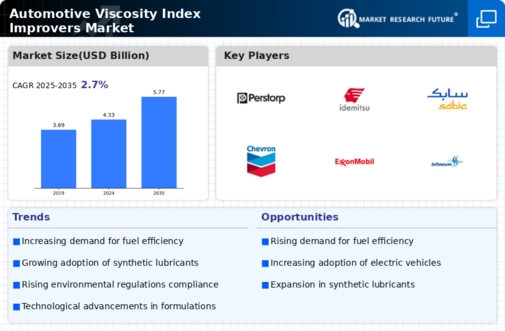Market Growth Projections
The Global Automotive Viscosity Index Improvers Market Industry is poised for growth, with projections indicating a market size of 4.33 USD Billion in 2024 and an anticipated increase to 5.77 USD Billion by 2035. This growth trajectory suggests a compound annual growth rate of 2.65% from 2025 to 2035, reflecting the industry's adaptability to changing consumer demands and regulatory pressures. The market's expansion is likely to be driven by factors such as technological advancements, increasing vehicle production, and a growing emphasis on sustainability. As the automotive landscape evolves, the role of viscosity index improvers in enhancing lubricant performance remains critical.
Stringent Environmental Regulations
Stringent environmental regulations significantly influence the Global Automotive Viscosity Index Improvers Market Industry. Governments worldwide are implementing stricter emission standards to combat pollution and promote sustainability. Consequently, automotive manufacturers are compelled to adopt advanced lubricants that incorporate viscosity index improvers to enhance fuel efficiency and reduce harmful emissions. This regulatory landscape fosters innovation in lubricant formulations, as companies strive to meet compliance while maintaining performance. The market's growth trajectory is expected to align with these regulatory developments, as the demand for eco-friendly automotive solutions continues to rise, potentially leading to a compound annual growth rate of 2.65% from 2025 to 2035.
Rising Awareness of Engine Maintenance
Rising awareness of engine maintenance among consumers contributes positively to the Global Automotive Viscosity Index Improvers Market Industry. As vehicle owners become more informed about the importance of regular maintenance and the role of high-quality lubricants, the demand for products containing viscosity index improvers increases. This trend is particularly evident in regions where vehicle ownership is on the rise, leading to a greater emphasis on engine care and performance. Consequently, manufacturers are responding by developing lubricants that not only meet performance standards but also cater to consumer preferences for longevity and efficiency. This growing awareness is likely to support market growth in the coming years.
Increasing Vehicle Production and Sales
The increasing production and sales of vehicles globally serve as a significant driver for the Global Automotive Viscosity Index Improvers Market Industry. As emerging economies experience rapid urbanization and rising disposable incomes, the demand for automobiles continues to grow. This trend necessitates the use of high-quality lubricants that incorporate viscosity index improvers to ensure optimal engine performance and longevity. The automotive sector's expansion is likely to stimulate the market, as manufacturers seek to enhance the efficiency of their products. With the market projected to reach 4.33 USD Billion in 2024, the upward trajectory appears promising, driven by the burgeoning automotive industry.
Growing Demand for High-Performance Lubricants
The Global Automotive Viscosity Index Improvers Market Industry experiences a notable surge in demand for high-performance lubricants, driven by the increasing need for enhanced engine efficiency and longevity. As automotive manufacturers focus on producing vehicles that meet stringent emission regulations, the incorporation of viscosity index improvers becomes essential. In 2024, the market is projected to reach 4.33 USD Billion, reflecting the industry's commitment to innovation and performance. This trend is likely to continue, as consumers increasingly seek vehicles that offer superior fuel economy and reduced environmental impact, further propelling the market forward.
Technological Advancements in Additive Manufacturing
Technological advancements in additive manufacturing play a pivotal role in shaping the Global Automotive Viscosity Index Improvers Market Industry. Innovations in polymer chemistry and formulation techniques enable the development of more effective viscosity index improvers that enhance the performance of lubricants. These advancements not only improve the thermal stability and shear resistance of lubricants but also contribute to the overall efficiency of automotive engines. As a result, manufacturers are increasingly investing in research and development to create next-generation additives that meet evolving industry standards. This focus on innovation is expected to drive market growth, with projections indicating a rise to 5.77 USD Billion by 2035.











